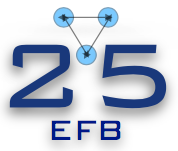Speaker
Description
In the last decades, exotic few-body atoms, in which an electron is replaced by an exotic particle, have attracted great scientific interest. These systems are indeed very useful to determine accurately the properties of their constituting exotic particles (e.g. antiprotons or mesons). For instance, an antiproton can be captured by a helium atom in a high orbital momentum state (typically L = 30 to 35) to form the so-called antiprotonic helium, a three-body system made of an alpha-particle, an electron, and an antiproton. This atom is in a high-L quasibound resonant state with very narrow width, hence long Auger lifetime. The radiative transitions between these quasibound states enable one to study these systems experimentally, and the recent study of antiprotonic helium led to the up-to-now most precise value of the antiproton mass [1,2]. Similar studies have been conducted with other exotic atoms, such as the pionic helium [3,4].
In order to give a comprehensive theoretical understanding of those systems, I will present a method for computing non-relativistic resonance energies and widths of three-body exotic atoms (namely, antiprotonic helium and pionic helium), for a wide range of the total orbital momentum L. I developed an approach combining the Lagrange-mesh method in perimetric coordinates [5–7] and the complex Kohn variational principle [8,9] in order to obtain the S-matrix related to the emission of the electron from the three-body system. By extrapolating this S-matrix in the complex plane from the real axis [10], the energies and widths of the states are determined. These widths are directly related to the Auger lifetimes of the system. I will show that this approach is suited for studying very accurately the resonances of these systems for a wide range of the orbital momentum L.
References :
[1] M. Hori, A. Sótér, D. Barna et al. Nature 475, 484–488 (2011).
[2] V. I. Korobov, Physical Review A 77, 042506 (2008).
[3] M. Hori, H. Aghai-Khozani, A. Sótér et al., Nature 581, 37–41 (2020).
[4] Z. D. Bai, V. I. Korobov, Z. C. Yan et al., Physical Review Letters 128, 183001 (2022).
[5] M. Hesse and D. Baye, Journal of Physics B 36, 139 (2003).
[6] D. Baye, J. Dohet-Eraly, and P. Schoofs, Physical Review A 99, 22508 (2019).
[7] D. Baye and J. Dohet-Eraly, Physical Review A 103, 022823 (2021).
[8] W. Kohn, Physical Review 74, 1763 (1948).
[9] A. Kievsky, Nuclear Physics A 624, 125-139 (1997).
[10] S. A. Rakityansky, S. A. Sofianos, and N. Elander, Journal of Physics A 40, 14857 (2007).

